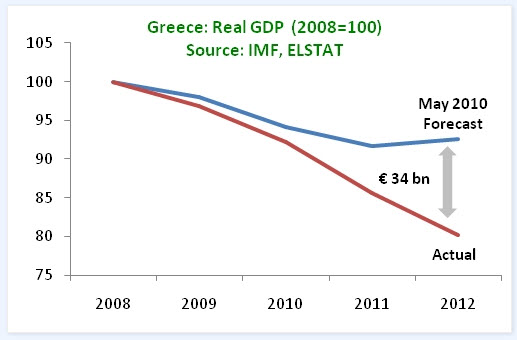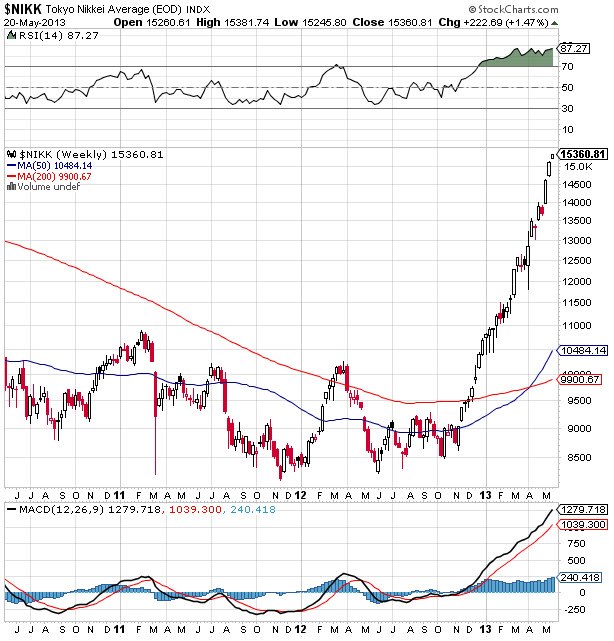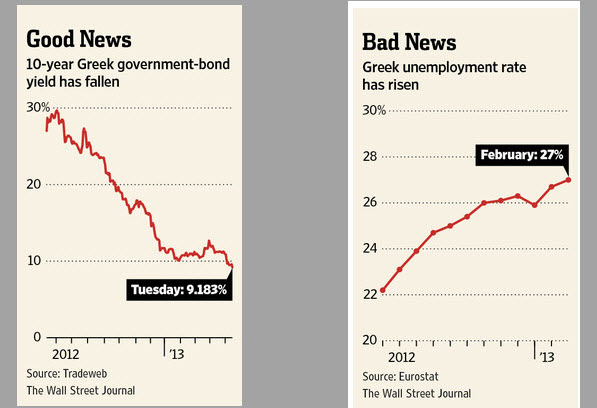Stock Market Back in Dangerous Bubble Territory
Stock-Markets / Stock Markets 2013 May 23, 2013 - 08:03 AM GMTBy: Dr_Martenson
 As the global equity and bond markets grind ever higher, abundant signs exist that we are once again living through an asset bubble – or rather a whole series of bubbles in a variety of markets. This makes this period quite interesting, but also quite dangerous.
As the global equity and bond markets grind ever higher, abundant signs exist that we are once again living through an asset bubble – or rather a whole series of bubbles in a variety of markets. This makes this period quite interesting, but also quite dangerous.
With equity and bond markets at or near all-time record highs, with all financial assets consistently shrugging off bad – or worse – news as the riskiest of assets continue to find consistent upward bids, we find ourselves in familiar and bubbly territory.
I can summarize my thoughts in one sentence: How could this be happening again so soon?
In times past, it took one or more generations between bubbles for people to financially recover and forget the painful lessons before they would consider doing it all again. Yet here we are, working our way through our third set of bubbles in less than two decades, which must be some sort of world record.
I will confess to my biases right up front: I have always been deeply skeptical of both the practice of running up debts at a faster pace than income (the common practice of the entire developed world over the past several decades) and the idea that the solution to too much debt is more debt, enabled by cheaper money courtesy of thin-air money printing.
In short, instead of seeing central banks as sophisticated stewards of intricate monetary policies, I view them as serial bubble-blowers and reckless debt-enablers whose only response, when confronted with the inevitable consequences of their actions, is to serve up more thin-air money at an even cheaper rate. And when that doesn't work, then they simply try even more of the same, but in larger quantities.
While I think central banks are populated by earnest people with impressive credentials who have rationalized their actions as being necessary and in service of the greater good, I also think that the biggest ones hold an entrenched set of institutional views that are dogmatic, fail to incorporate the idea of economic and resource limits, and are seemingly immune to healthy introspection.
Somewhere along the way, I would have hoped they might have noted that each new crisis is larger than the one before – necessitating an even larger response that begets an even larger crisis next time, etc., and so on. A corporate bond hiccup in 1994 led to monetary loosening that enabled the development of the Long Term Capital Management (LTCM) fiasco of 1998, which was followed by the tech bubble, and then the housing bubble, and here we are with a now global equity and bond bubble that is larger than all the prior bubbles combined. Much larger.
It was famously said that the market can remain irrational longer than you can remain solvent. And if the trading maxim, don't fight the Fed, is worth heeding, then surely one should absolutely not take on all of the central banks at once, either. So, the risk I run here in seeing things through my 'common sense' filter is that perhaps this time the Fed, et al., have got it right, and a true and lasting recovery is at hand.
With that caveat, in this report I lay out the five most worrisome signs that horrific market losses await the unwary, the careless, the reckless – and those who possess all three characteristics (i.e., your average central bank).
These are not normal times. The degree of separation between reality and today's financial markets is extreme, which means they have a tremendous degree of potential energy stored up that could erupt in a downward cascade at any time.
While we can’t predict the exact time or trigger of a market avalanche back down to reasonable levels, I can definitely advise that you do not want to be standing in the valley when it happens.
Four Signs That We're Bubbling
Here are the four things that convince me that we are in truly bubbly territory:
Sign #1: Junk Bond Prices at Record Highs
The Fed, et al., have been buying up all of the 'safe' bonds, with the twin intents of driving down interest rates and chasing investors into riskier assets. With lower yields comes (hopefully) more borrowing; and when investors move towards riskier assets, this drives up the equity markets – which, as the thinking goes, will paint a rosier picture of the economy plus boost consumer confidence and spending.
Along with this, however, we find speculators and investors, starved for yield, chasing the junkiest of the junk.
Indeed, the prices of these "assets" have recently been driven to all-time record highs, which means that their yields have hit record lows.
And not just "low" prices, but a brand new record low in all of financial history.
Sign #2: Junk Sovereign Debt Being Chased to New Highs
It was just over a year ago when Greece ten-year debt was yielding a whopping 30%, reflecting the poor economic fundamentals of the country and concern that the European Central Bank (ECB) might stop loaning Greece the principal and interest payments needed to prevent another default.
Oh yes, and let's not forget that just a year prior, more than $130 billion had been lost by Greek bond investors, which created a ripple effect across Europe, including recently crippling Cyprus' key banks.
Today? Greek ten-year debt is under 10%.
Greece Bulls Charge Into Corporate Bonds
May 15, 2013
Investors are returning to Greece, lured by receding fears that the troubled country will leave the euro and the high returns offered by many of its battered assets.
It is a remarkable turnaround. Only a year ago, Greece was toxic territory for investors. A debt restructuring had just wiped out more than €100 billion ($130 billion) in government bonds. The stock market stood at one-tenth its 2007 levels. A political earthquake had the country poised for a chaotic election.
But now the markets have turned. Months of relative calm in Europe – and the pressure to go somewhere, anywhere, for yield in a low-interest-rate world—has investors taking another look. The Athens stock market has rallied more than 80% in the past 12 months, with the Athex Composite Index rising 0.8% on Tuesday. Greek government bonds have been on a tear since June.
The real story here, about speculators – not ‘investors’ – returning to Greece, is that the world is so utterly starved for yield that even Greek debt seems reasonable now. In Greece, even as the trend towards buying Greek debt was building, the country's economy (as measured by unemployment and GDP) deteriorated sharply.
As compared to 2008, Greek GDP in 2012 shrank by 20%, and current trends continue to show 5%-6% shrinkage in 2013:

(Source)
In what sort of a world does serious economic contraction, spiking unemployment, extremely high levels of debt-to-GDP, and falling bond yields go together? A bubbly world, that's where.
Sign #3: It's Not Official Until It's Denied
The poster child for a bubble market has to be Japan, where the main stock index of the island nation, the Nikkei, is up an astonishing 70% in the past six months (!) in a vertical index rise that is well outside of our personal experience:

This isn't some penny stock, but the entire stock index for the world's third largest economy. Of course, the 'reason' for this rise centers on the actions the Bank of Japan is taking to debase its currency. The people of Japan are realizing that they cannot trust their cash and had better put it to use somewhere besides their bank accounts before its purchasing power is drained away.
After such an obviously unstable spike in the market, what's left to do but officially deny that it's in a bubble?
Stock Boom Isn't a Bubble, Says BOJ's Kuroda
May 15, 2013
TOKYO—The Bank of Japan's governor played down worries that the stock-market boom is a bubble and that a weak yen will stir cost-push inflation, signaling his resolve to press ahead with the bold monetary easing that has fueled stock prices and driven down the currency.
Grilled by lawmakers during a session of the upper-house budget committee, Haruhiko Kuroda flatly rejected an opposition-party member's argument that the recent rapid rise in the Tokyo stock market is out of line with Japan's real economy.
"At this moment I do not think they are in a bubble," Mr. Kuroda said.
Driving this bubble is the determined resolve of the BoJ to make the yen worth less, perhaps even someday worthless. For a major world currency, the chart below is quite startling.

If something is not official until it's denied, then the Japanese stock market is most definitely in a bubble. It should be noted that there are similar examples of stock indexes making new highs on bad news and weak fundamentals the world over, so we're not just picking on Japan alone here.
Sign #4: Making Up Crazy Excuses
My final sign of that we are in bubble territory is when the folks who consider it their job to make sense of the high and spiking prices offer up thin, sometimes stretched-to-the-breaking-point, rationalizations for why the current price action make sense.
In the late 1990s, when the third most recent Fed bubble was cooking along, stratospherically valued technology shares were justified with strange metrics such as 'impressions' and 'eyeballs' and other contorted valuations contained in no standard finance methodologies.
In the 2000s, when the second most recent Fed bubble was cooking along, housing prices were justified with trite slogans such as "they're not making any more land, you know" and bizarro claims that housing had never gone down in price over time – which it most certainly had.
Today is no different. We're seeing the same sorts of 'explanations' to justify high prices fueled by central bank printing. Perhaps the central cheerleader for the benefits of perpetuating central banking policy errors is Paul Krugman, who recently swept aside arguments for an equity bubble by saying something that Irving Fisher might recognize:
O.K., what about stocks? Major stock indexes are now higher than they were at the end of the 1990s, which can sound ominous. It sounds a lot less ominous, however, when you learn that corporate profits— which are, after all, what stocks are shares in — are more than two-and-a-half times higher than they were when the 1990s bubble burst.
Also, with bond yields so low, you would expect investors to move into stocks, driving their prices higher.
(Source)
This sounds reasonable until you consider the context of this argument about corporate profits, of which an economist like Krugman ought to be fully aware. Corporate profits are in very, very unusual territory (one could even say record territory), and to say that equities are fairly valued now because of their relationship to corporate profits is to argue that such profitability is a new and permanent feature of life.
The economist Irving Fisher somewhat famously and regrettably opined in 1929 (right before the stock market crashed) that a new corporate model and economic era was in play that had led to a "permanent plateau of prosperity." The rest is history.

In life and investing, there's nothing quite so powerful as reversion to the mean, which in the case of corporate profits is nearly 50% lower than where they currently are. By the time that economists are dismissing the notion of an equity bubble by pointing out heightened corporate profits, without providing any of the necessary context, we are in full-blown rationalization mode – which is another bubble indicator.
Also, the fact that Mr. Krugman is citing "low bond yields" as a justification for moving into stocks rather delightfully skips over the reality that it is the central banks themselves that are responsible for those low bond yields. Krugman presents the information as if such intervention were a normal market condition to which investors were rationally reacting, rather than a completely fake circumstance engineered by central banks conducting the biggest monetary experiment in human history.
Next, we have this tidy explanation from Goldman Sachs, groping for reasons to explain why stocks always seem to go up no matter what:
"while equity prices respond more to dovish surprises than hawkish surprises, the results suggest that equity prices typically go up regardless of whether the Fed policy surprise is positive or negative (“good news is good for equities, and bad news is good for equities”). But it is not at all clear why the equity market should systematically buy into this pattern."
This is at least as honest an appraisal of the situation as I can find. Goldman Sachs is basically waving its hands in the air and saying that it's somewhat puzzling why markets should be acting this way. An even more honest statement would continue by noting that such periods of irrational exuberance are quite often found during bubbles, and that bubbles have a bad habit of destroying wealth.
As is common in life, such justifications merely expose the 'human factor' of bubbles. Bubbles require a belief system to be installed in the beholder, and two things that beliefs are exceptionally good at are gathering supporting data and rejecting contradictory data (if such data is even seen in the first place).
The human mind does this all the time with respect to our own level of ability, our luck, our good looks, our children's performance – you name it – this is just part of our innate mental programming.
The really odd part in this story is that once upon a time, bubbles were separated by a generation or more, so that the lessons (and pain) of the prior one could be culturally forgotten before the next one could take hold. Yet here we are, working on our third bubble in a row – larger than the prior two that just happened within the past 15 years. (Of course, with a wide enough lens, we might say that each bubble was just a subset of the largest credit bubble in all of history that began building some 40 years ago).
For some reason, we are forgetting the lessons of the past faster than ever before. Such willful ignorance invites a series of reality-based reversions more punishing than ever before, too.
My advice: Keep a journal. These are interesting times; possibly not to be repeated in many, many generations.
Conclusion to Part I
There are abundant signs that the world's equity and bond markets are ignoring risk and chasing yield to dangerous extremes. Various denials and justifications are being offered to rationalize these behaviors as sensible or prudent. Taken together, this tells me we are once again in bubble territory, and that, as with all bubbles, this one will end badly. Or rather, these bubbles (plural) will end badly together.
I'm sure that most market participants have it in their minds to dance as long as the music is playing and to be among the first to reach the exits when the music stops. However, everybody is thinking this, and given that only the most well-connected of market players have the opportunity to exit first (literally in the blink of an eye), very few will actually make it through the doorway unscathed.
As is always true in life, the point of a bubble is to separate the most people from the most wealth. The wealth doesn't actually vanish; it's just simply transferred from the last purchasers to those who sold before the bursting.
I truly have no idea how much longer all this craziness can continue. I suspect the answer is a lot longer than anybody suspects, myself included. But I also know that reversals tend to happen quite quickly, all on their own, with very little warning. This leads to my personal motto: I'd rather be a year early than a day late.
In Part II: Protect Your Wealth in Advance of the Bubble's Bursting, we detail our rationale that all this ends in a wrenching market crash (Phase I), which will be followed by even larger, more desperate, and unusual central bank actions (Phase II) that will initially set the stage for what seems like a recovery but ultimately terminates in the largest currency crisis of modern times, if not human history (Phase III).
The difficulty will be avoiding being whipsawed throughout, losing wealth at every step. After all, the primary outcome of every attempt at money printing in the past has been a massive wealth transfer from a very large proportion of the afflicted society to a much smaller one.
Click here to access Part II of this report (free executive summary; enrollment required for full access).
In the meantime, trade safe. My advice here is to use extreme caution whether investing or speculating, whichever you are involved in.
By Dr Martenson
© 2013 Copyright Dr Martenson - All Rights Reserved
Disclaimer: The above is a matter of opinion provided for general information purposes only and is not intended as investment advice. Information and analysis above are derived from sources and utilising methods believed to be reliable, but we cannot accept responsibility for any losses you may incur as a result of this analysis. Individuals should consult with their personal financial advisors.
© 2005-2022 http://www.MarketOracle.co.uk - The Market Oracle is a FREE Daily Financial Markets Analysis & Forecasting online publication.




